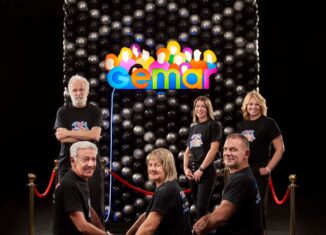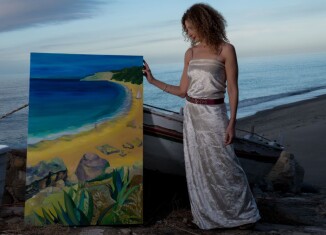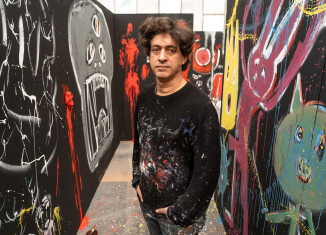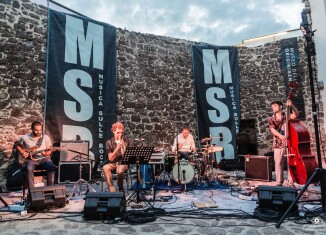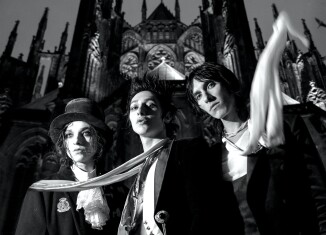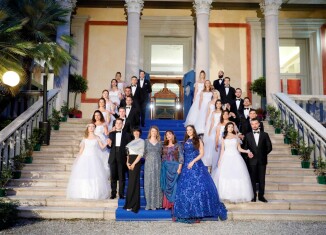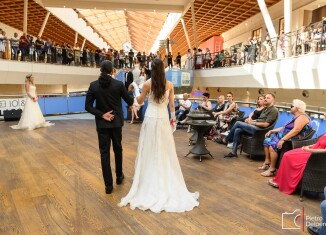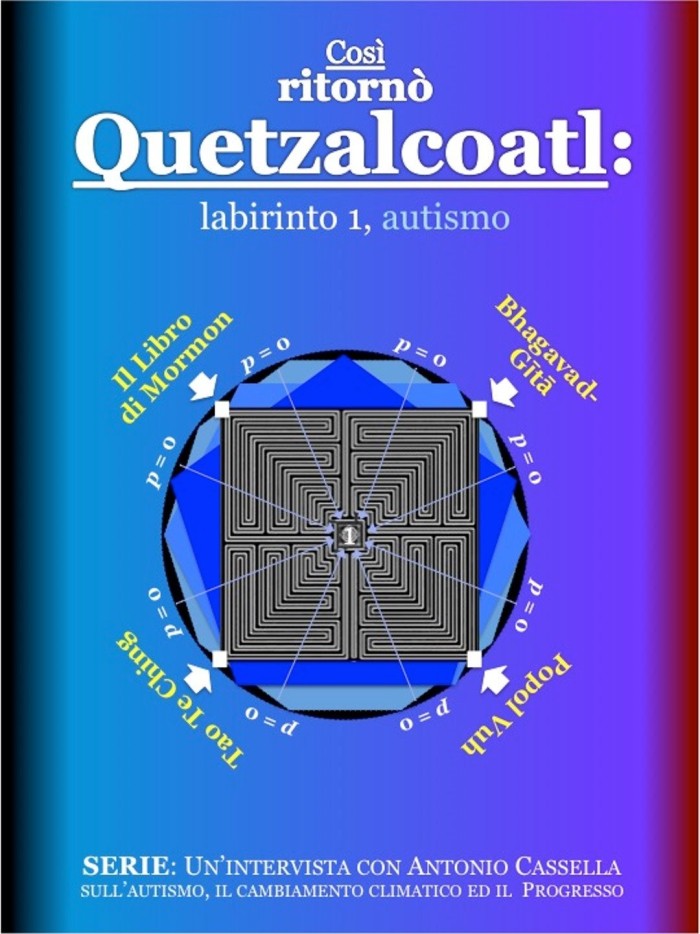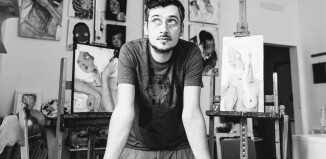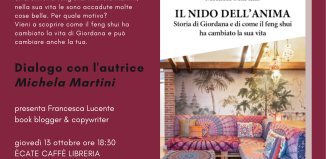Intervista – Il ritorno di Quetzalcoatl: il disturbo autistico tra razionalità e creatività
[tp lang=”it” only=”y” not_in=”en”]
Presentazione di Irene Tempestini
Intervista a cura di Donatella Marcovigi
Cosa si nasconde tra la realtà inflessibile e l’arte flessibile, il pensiero perfetto e la teologia meno-che-perfetta, la razionalità e la creatività, lo yang e lo yin, il sole e la luna? L’euristica logos sulle radici cognitive dei disturbi dello spettro autistico (DSA) studiata dal Dott. Antonio Cassella vede la nascita di una Terza Attenzione, il ritorno di Quetzalcoatl, ovvero un’Alleanza tra la conservazione (caratteristica dello spettro autistico) e il rinnovamento , tra la memoria autistica (prima attenzione) di ciò che è risaputo e la memoria artistica (seconda attenzione) di ciò che non abbiamo mai conosciuto, tra la computazione classica nella prima attenzione e la computazione quantica nella seconda attenzione.
Anticipando le parole che il Dott. Cassella riferirà nell’intervista a seguire (realizzata con ammirevole competenza dalla nostra inviata in Florida Donatella Marcovigi, che ringraziamo pubblicamente), come succede ad un serpente che si nasconde sotto le pietre di una collina, gli autistici non possono lasciare la terra del mondo “sì-coatl” (sí-serpente), il lato razionale della mente umana. Mentre, come succede ad un uccello che non può sostare troppo a lungo su una duna, gli schizofrenici non possono lasciare il cielo del “no-quetzal” (no-uccello), il lato irrazionale della mente umana.
Nella prima attenzione diretta dalla computazione neurale classica, il mondo della sanità mentale e il mondo della follia sono separati tra loro come il mondo dei serpenti è separato dal mondo degli uccelli. Gli autistici non possono diventare un “coatl-quetzal” (serpente-uccello) e gli schizofrenici non possono trasformarsi in un “quetzal-coatl” (uccello-serpente).
Gli autistici e gli schizofrenici non possono navigare sulle acque ambigue del “sì-e-no”, mentre il nostro io-Quetzalcoatl si destreggia nell’ambiguità ed ha sempre la possibilità di scegliere tra il sì e il no, o di combinare estremi opposti in una nuova armonia, nel ritorno di Quetzalcoatl. Gli autistici e gli schizofrenici vedono verità sconosciute in mondi isolati, senza andare e ritornare sulla strada aperta dal dubbio e dall’inganno.
Per zest.today è un grande onore e privilegio aver incontrato e intervistato il Dott. Cassella, che ci ha gentilmente concesso di pubblicare la sua teoria euristica logos sul DSA, argomento delicato e non senza implicazioni emotive, visto che conosciamo personalmente una ragazza bellissima, abile e affascinante pittrice, affetta da questo disturbo, e sappiamo bene che dentro quel suo mondo, che spesso viene guardato con distacco e timore, vi è una luce, bella, calda e ricca di spunti da cui attingere, ma che troppo spesso facciamo finta di non percepire, per paura o per stupida pigrizia.
Non è un argomento facile, ma vi assicuriamo che “Così ritornò Quetzalcoatl: labirinto 1, Autismo” vi trasporterà in mondi inesplorati, attraverso un viaggio nella mente che non può non lasciare segni e indurre alla riflessione sui mondi misteriosi della creatività.
[ Irene Tempestini, Direttore Responsabile]
_________________
[Donatella Marcovigi]
DOTT. CASSELLA, CHE SEGRETI COGNITIVI HA RACCHIUSO NEL SUO LIBRO “Così ritornò Quetzalcoatl: labirinto 1, Autismo”
Nei tre labirinti della Serie Così ritornò Quetzalcoatl: Un’intervista con Antonio Cassella sull’autismo, il cambiamento climatico ed il Progresso, rivedo la nascita della Terza Attenzione: l’Alleanza tra la conservazione voluta dalla prima attenzione, meno danneggiata nelle persone colpite dai disordini dello spettro autistico (DSA), e il rinnovamento voluto dalla seconda attenzione, che si allontana da ogni autistico prima che compia i tre anni.
Per esempio:
a. la memoria autistica di ciò che è risaputo, e la memoria artistica di ciò che non abbiamo mai saputo;
b. la semantica che conserva il significato delle parole, e la pragmatica che le adorna di nuove metafore;
c. la lettura ad alta voce del Rosario, e la comprensione delle sue implicazioni cognitive;
d. l’interpretazione letterale di un Testo Sacro, e gli insegnamenti nascosti dietro la lettera;
e. la lettera “a” invariabile dell’alfabeto latino, e la “b” che diventa “d”, “p” e “q” quando la ruotiamo;
f. la Teoria della relatività di Einstein, e la cromo-dinamica quantica di Murray Gell-Mann;
g. la solitudine dell’ostia consacrata prima della Consacrazione, e la proposizione di Martin Lutero al Concilio di Trento che, dopo la Consacrazione ma prima della Transustanziazione, l’ostia e il corpo di Gesù Cristo condividono lo stesso spazio allo stesso tempo.
h. l’odio di chi mette in croce un altro, e l’amore di chi benedice i suoi aguzzini;
i. i viaggi di Maometto prima di incontrare l’arcangelo Gabriele, e il suo viaggio in una stessa notte alla moschea-più-lontana-dell’universo, all’inferno e al paradiso, prima di tornare alla Mecca;
j. l’abilità di Cristo di guidare la mano di Tommaso nella sua ferita, e la sua capacità di entrare nella casa dei suoi apostoli senza aprire la porta sbarrata;
k. la rigidità del deserto di Hejaz, e la flessibilità del khumrah di paglia sul quale si inginocchiava il Profeta per benedire i bambini dell’universo;
l. i due eserciti colmi di parenti ed amici, pronti a lottare all’ultimo sangue di fronte allo sguardo angosciato di Arjuna, e la serenità del Signor Krishna, al finale del Baghavad Gita, quando loda gli eroi che superano se stessi superando un dilemma;
m. L’irreversibilità apparente della seconda legge della termodinamica quando i Signori degli Xibalba fanno a pezzetti Xbalanqué and Hunahpú nel Popol Vuh dei maya, e la sua reversibilità apparente quando i gemelli risorgono in segreto e ingannano i loro assassini, convincendoli che rivedranno i loro palazzi dopo essere stati uccisi;
n. la volontà rigida del romano Marco Terenzio Varrone, e la volontà flessibile del cartaginese Annibale Barca alla battaglia di Cannae nel 216 PEC (Prima dell’Era Comune);
o. l’amore della pietra di Gilgamesh, e l’amore della selva di Enkidu;
p. l’ubbidienza autistica di Adamo, e la disobbedienza artistica di Eva;
q. l’arhat hinayana che cerca la sua illuminazione personale, e il bodhisattva mahayana che cerca di illuminare i suoi nemici;
r. vedere un fiore di loto, e capire perché nasce dal fango;
s. la rigidità di Kong Fuzi, e la flessibilità di Laozi;
t. la chiarezza del yang maschile, e l’oscurità del yin femminile;
u. l’attenzione focalizzata nella meditazione buddista, e l’attenzione simultanea che permette al Dalai Lama, senza mai lasciare Dharamsala, di sedersi sulla sedia già occupata dallo Zio che governa da Pechino;
v. la sequenza seguita dalla freccia, e la simultaneità dell’arco che unisce e separa estremi opposti;
w. gli schiaffi del sole e le carezze della luna;
x. la piramide del Sole, e quella della Luna a Teotihuacán;
y. la computazione classica nella prima attenzione, e la computazione quantica nella seconda attenzione;
z. i viaggi di qualsiasi “coatl-serpente” sulla Terra, e il viaggio di andata e ritorno del semidio Quetzalcoatl a Venere, per arricchire alcuni di noi con il segreto della Terza Attenzione.
POTREBBE DIRMI CHI ARRICCHIRÀ IL SUO LIBRO?
L’euristica logos nei tre labirinti di “Così ritornò Quetzalcoatl” arricchirà tanto i ricchi che non sentono le conseguenze del loro consumo eccessivo sulla Grande barriera corallina dell’Australia, quanto i poveri che cantano “Burn, baby, burn!” per il dispiacere di non avere le ricchezze che vedono. Sono sicuro che la persona più povera al mondo non cambierebbe la sua ricchezza cognitiva per la povertà cognitiva di un autistico pieno di soldi. Oggi, ricchi e poveri, i leader maliziosi e i fondamentalisti che ubbidiscono le loro scempiaggini sono ciechi alla nascita della Terza Attenzione. Però, se leggessero “Così ritornò Quetzalcoatl”, 1. i genitori, gli insegnanti e gli amici di persone colpite dal DSA troveranno la loro Terza Attenzione e aiuteranno i loro cari a ritrovare l’uso umanistico della seconda attenzione; 2. gli studenti universitari travolgeranno ostacoli nelle loro scelte; 3. i ricconi troveranno e condivideranno il segreto dell’energia nascosta dietro i gluoni; e 3. le nazionali di calcio, baseball e cricket più indietro nel mondo arriveranno prime. Detto questo, non è detto che l’euristica logos sulle radici cognitive dell’autismo e del ritorno di Quetzalcoatl sia senza errori. Per questo, cercherò di correggere gli errori che mi fossero segnalati alla mail researchautism.1@gmail.com.
PUÒ DIRMI QUAL È LA RELAZIONE TRA AUTISMO E QUETZALCOATL?
Dopo aver distrutto Tenochtitlan nel 1521, Hernán Cortés implicò nelle sue lettere all’Imperatore Carlo V che gli Aztechi si erano lasciati ingannare con gran facilità. Cortés non scrisse mai che Moctezuma II, il nono tlatoani degli aztechi, aveva creduto che lui fosse il semidio Quetzalcoatl che tornava da Venere. Cinquant’anni dopo la conquista del Messico, tuttavia, il frate francescano Bernardino de Sahagún scrisse che il Discorso di Moctezuma a Cortés nel 1519 includeva due frasi in cui quel “Conquistador” era considerato l’erede legittimo della cultura azteca-náhuatl che manteneva assieme i mexica, acolhua e tepanec. In realtà, Hernán Cortés conquistò il Messico perché aveva quattro jolly in mano: 1. La memoria autistica del carpentiere che ricostruì le caravelle con le quali Cortés attraversò il lago che circondava la capitale azteca; 2. un marinaio con il vaiolo, la malattia europea che fece a pezzi la forza dei difensori di 3 Tenochtitlan; 3. l’aiuto di 150.000 alleati locali, che chiusero il somministro di acqua alla città, rafforzarono gli archibugieri e i cavalieri spagnoli indeboliti dalla sifilide americana, e massacrarono 250.000 aztechi; e 4. l’ignoranza dei mexica sul significato esoterico del ritorno di Quetzalcoatl a Teotihuacan.
Nel secolo XIII, quando alcuni mercenari mexica arrivarono nella Valle del Messico, videro le rovine di Teotihuacan, una città che era stata abbandonata 600 anni prima. I toltechi che vivevano in quella valle portarono i mexica alla vista di tre monumenti: la Piramide del Sole, la Piramide della Luna, e quella che i toltechi attribuirono a un semidio che chiamarono letteralmente “Uccello-Serpente-”, o “Quetzal-Coatl” in lingua nahuatl. I toltechi ignoravano il ruolo esoterico di Quetzalcoatl nell’universo olmeca-maya che aveva prodotto quel dio-umano. E forse non lo sapevano neanche i Signori di Teotihuacan, dal momento che il popolino bruciò le case dei sacerdoti che cercavano di sognare come frenare gli effetti di una siccità prolungata. L’ignoranza sui vantaggi dell’Alleanza tra la computazione classica di Huitzilopochtli, il dio-Sole degli aztechi, e la computazione quantica della Luna, o la sorella che Huitzilopochtli fa decapitare, è la causa della cecità di Moctezuma II al tradimento di Hernán Cortés.
La mia ricerca sul DSA mi invita a supporre che la piramide della Luna a Teotihuacán è un riflesso della dinamica cognitiva che gli autistici perdono prima di compiere i tre anni; i fondamentalisti perdono dopo i tre anni; e i geni del male che dirigono i fondamentalisti perdono prima di svegliarsi in un paradiso autistico o in un inferno schizofrenico.
QUAL È IL RUOLO DI QUETZALCOATL NELLA MENTE UMANA?
Come succede ad un serpente che si nasconde sotto le pietre di una collina, gli autistici non possono lasciare la sicurezza del mondo “sì-coatl”, il lato razionale della mente umana. Come succede ad un uccello che non può sostare troppo a lungo su una duna, gli schizofrenici non possono lasciare il cielo del “no-quetzal”, il lato irrazionale della mente umana. Nella prima attenzione diretta dalla computazione neurale classica, il mondo della sanità mentale e il mondo della follia sono separati tra loro come il mondo dei serpenti è separato dal mondo degli uccelli. Gli autistici non possono diventare un “coatl-quetzal” (serpente-uccello) e gli schizofrenici non possono trasformarsi in un “quetzal-coatl” (uccello-serpente). Gli autistici e gli schizofrenici non possono navigare sulle acque ambigue del “sì-e-no”, nel mondo della seconda attenzione diretto dalla computazione quantica. Il nostro io-Quetzalcoatl, invece, naviga con facilità la corrente dell’ambiguità; ma deve pur tornare al porto-del-sì o al porto-del-no. Risulta troppo pericoloso cantare senza sosta “Quizás, Quizás, Quizás” con Nat King Cole sul mare della computazione quantica.
PERCHÉ GLI AUTISTICI NON COMPRENDONO LA COMPUTAZIONE QUANTICA?
Gli autistici non comprendono il dubbio. Anche se possono sviluppare tic pazzeschi, l’io esplicito degli autistici non può trasformarsi in un “serpente-uccello” in cerca della pazzia virtuale. Solo la velocità infinita di Quetzalcoatl permette al nostro io implicito di abbracciare simultaneamente il sì- autistico ed il no-schizofrenico quando navighiamo lungo la corrente della parola “chissà” fino alla scritta “lasciate ogni speranza o voi che entrate!” Solo la velocità infinita di Quetzalcoatl ci permette di rubare una nuova melodia alla malizia del diavolo, o di riceverla dalla grazia dell’arcangelo Gabriele, prima di tornare al mondo familiare come un “uccello-serpente”. 4 Capire ed aiutare gli autistici porta ad apprezzare l’alleanza tra le memorie vecchie custodite nel porto dell’io esplicito e le memorie nuove portate a casa dalle navi dell’io implicito.
L’iperspazio (o superspazio) di andata della coerenza quantica tra la Terra e Venere e l’iperspazio di ritorno della decoerenza quantica potrebbero essere presi metaforicamente come un mare tempestoso attraversato da tachioni sognatori più veloci della luce. Non andrà mai bene consegnare il mare dei nostri tachioni ribelli ai bradioni leali di un tiranno, come fecero i 6 “stans” dell’Asia Centrale quando consegnarono il Mare di Aral ai neuroni-specchio di Stalin. I neuroni-specchio conservano la nostra memoria alla velocità subluminale della luce del Sole.
I tachioni di Quetzalcoatl, invece, si appoggiano alla velocità superluminale della luce di una Luna curiosa e nostalgica per trovare nuovi tesori di conoscenze al bordo della pazzia, e poi condurli al porto custodito dai bradioni della prima attenzione. Come successe a Vincent van Gogh, i nostri sogni di gloria potrebbero avverarsi dopo essere diventati pazzi, o dopo essere morti—come lo testimonierebbe il fantasma di Georges Bizet (Carmen). In verità, ogni artista sogna che i suoi incontri con la terza attenzione attrarranno l’attenzione simultanea dei tachioni di una donna favolosa. Leonardo da Vinci, per esempio, racchiuse il segreto della Terza Attenzione nel sorriso enigmatico di una donna: Monna Lisa.
QUAL È IL SIGNIFICATO DEL SORRISO DI MONNA LISA?
Il sorriso di Lisa del Giocondo denota tanto la curiosità che impulsa la nave della coerenza quantica a lasciare il mondo conosciuto quanto la nostalgia che impulsa la nave della decoerenza quantica a tornare al mondo che diamo per scontato. Tanto nel viaggio di andata della curiosità quanto nel viaggio di ritorno della nostalgia, il mare della computazione quantica sostiene la nostra visita simultanea al mondo dell’autismo e al mondo della schizofrenia. Da una parte, la curiosità nel sorriso della Monna Lisa nasconde la velocità infinita del pensiero nell’Ubiquità della coerenza di chi si trova in mondi opposti allo stesso tempo, prima di girare attorno allo zero trascendente della Coincidenza.
Dall’altra parte, la decoerenza è qualcosa di più della speranza nascosta nella nostalgia del sorriso della Monna Lisa. Nel 1950, Nat King Cole cantò in Mona Lisa: “Many dreams have been brought to your doorstep!” (“Molti sogni bussano alla tua porta!”). Nat King Cole intuì che Monna Lisa riflette il mondo dei sogni che diventeranno realtà, la creazione, la Complementarità tra la computazione classica e la quantica, ed il ritorno di Quetzalcoatl. Quando lo spaziotempo illuminato dalla luce abbraccia l’iperspazio annerito dalla velocità infinita dei neutrini, quando i bradioni abbracciano i tachioni, e i partner abbracciano i super-partner, allora la prima attenzione abbraccerà la seconda attenzione nella nascita della Terza Attenzione e nella fuga definitiva di Clint Eastwood da Alcatraz.
SA DI QUALCHE OPERA DOVE LEONARDO, NO CLINT EASTWOOD, ABBIA SPIEGATO L’ARMONIA DELLA CREAZIONE?
Leonardo spiegò il funzionamento dell’universo e della mente umana nel suo disegno dell’Uomo Vitruviano. Devo ricordare che nel 1414 l’umanista Poggio Bracciolini trovò nel monastero di Montecassino una copia del libro De Architectura di Marco Vitruvio Pollio. Leonardo rimase affascinato dal fatto che anche Vitruvio aveva guadagnato la sua pensione come ingegnere militare. Vitruvio disegnò l’anello tra la circumvallatio e la contravallatio intorno ad Alesia, che difese Giulio Cesare dagli attacchi di Vercingetorige chiuso in quella città, e di suo cugino Vercassivellauno accorso in suo aiuto dall’Arvernia. Le armi letali con cui Cesare smembrò o vendette come schiavi milioni di galli furono probabilmente disegnate da Vitruvio. Leonardo accettò la conclusione di Vitruvio che la simmetria del corpo umano riflette la relazione tra il circolo ed il quadrato. Leonardo capì che la diagonale irrazionale del quadrato ed il quoziente irrazionale tra qualsiasi circonferenza e il suo diametro impediscono la trasformazione di un circolo in un quadrato, e viceversa, mediante un righello ed un compasso. Per quello, centrò il circolo nell’ombelico del suo Uomo di Vitruvio; ed il quadrato, nel vertice del triangolo sormontato dai suoi due recipienti genetici.
PUÒ SPIEGARE IL VIAGGIO DELLA CREAZIONE NASCOSTO NELL’UOMO VITRUVIANO?
La decisione di Leonardo di separare il circolo dal quadrato porta a distinguere i quattro momenti della creazione. Siccome non abbiamo di fronte il disegno dell’Uomo Vitruviano, potrei avvalermi del suo aiuto se lei si togliesse le scarpe, senza far caso agli sguardi incuriositi dei clienti di questa Libreria-Caffè!
CHE DEVO FARE?
Appoggi il suo piede destro su questo sgabello a sinistra, e il suo piede sinistro su questa panchetta alla mia destra; alzi le braccia stese, e metta la punta delle sue mani a livello delle radici dei suoi capelli, come se fosse la lettera “X”. Adesso immagini che i suoi piedi separati riposino su un circolo, mentre i diti medi delle sue mani estese sfiorano la parte superiore di quello stesso circolo. Immagini anche che, oltre al circolo, le sue dita tocchino i due vertici superiori di un quadrato, il cui lato inferiore sopporta i due sgabelli sul pavimento dello studio, mentre il lato superiore riposa sulla sua testa. Finalmente, assuma che la “X” del suo corpo rappresenta l’avatar “Legge” dell’Uomo Vitruviano, la conoscenza condivisa, ed il lato autistico dell’universo.
Siccome le pesano le braccia, le scenda pure a livello delle spalle, strisciando le sue dita contro i due lati del quadrato. Le sue mani hanno lasciato il circolo mentre lei strisciava i lati del quadrato; ma i piedi delle sue gambe aperte riposano ancora sul circolo sostenuto dai due sgabelli appoggiati sul quadrato. Siccome lei si trova in parte nel circolo ed in parte nel quadrato, in questo momento lei è un riflesso della cresta di una montagna, o l’avatar “Montagna” dell’Uomo Vitruviano. Un buon esempio, e la rigidità orizzontale della “Cuchilla del Niño” (“Cresta del Bambino”) senza nubi, quando questa montagna ammira con certa invidia le curve della amazzoni a cavallo che partecipano alla cavalcata annuale celebrata a Zea, nelle Ande venezuelane. Mantenendo le braccia stese, scenda pure dagli sgabelli ed unisca pure i suoi piedi sul pavimento. Lei è diventata la “Croce”.
Le sue mani toccano i lati del quadrato e i suoi piedi riuniti riposano simultaneamente sul quadrato e sul circolo. La Croce appartiene fondamentalmente al quadrato, o al lato schizofrenico dell’universo: Lei è impazzita! Manca solo un’emanazione dell’Uomo Vitruviano. Alzi le braccia e mani nella posizione iniziale della Legge. Siccome le sue mani sfiorano il circolo ed il quadrato e i suoi piedi riuniti calpestano tanto il circolo come il quadrato, il suo corpo appartiene simultaneamente al circolo della sanità mentale e al quadrato della pazzia. Lei si è trasformata nell’“Aquila” olmeca: la Terza Attenzione universale che riunisce la computazione classica e la quantica, la memoria dimenticata dagli Alzheimer, e la memoria dimenticata dagli autistici.
MENTRE SCENDO LE BRACCIA, OSO DOMANDARE, QUAL È IL SIGNIFICATO ESOTERICO DEI QUATTRO AVATAR DELL’UOMO VITRUVIANO?
La Legge rappresenta il circolo razionale adorato dagli autistici; il lato autistico della mente umana; la computazione classica; le conoscenze date per scontate; ed il coatl degli aztechi. La Montagna rappresenta il mare della coerenza quantica ed il viaggio di Quetzalcoatl dal circolo del coatl-sì al quadrato del quetzal-no. La Croce rappresenta il quadrato irrazionale del quetzal; cioè, l’inferno dove cerchiamo nuovi tesori di conoscenza strizzando l’occhio al diavolo, o ascoltando le poesie di Gabriele. Finalmente, l’Aquila è una metafora del ritorno di Quetzalcoatl, dal quadrato della pazzia-quetzal al circolo della sanità-coatl, con la rivelazione di un segreto.
Nel Campionato Mondiale di Calcio del 2006, per esempio, il circolo dell’italiano Marco Materazzi lanciò un insulto amaro nel quadrato del francese Zinedin Zidane; e il circolo di Zidane piazzò una testata pazzesca nel quadrato di Materazzi. Quei due giocatori misero in pericolo l’integrità della Montagna e della Legge. La perdita definitiva del lato artistico e del lato autistico del se stesso diventò realtà nel caso dell’attore Bela Lugosi, quando riuscì a contare esattamente il numero dei globuli rossi del Conte Dracula. La nostra Montagna cerca la Grazia dell’Arcangelo Gabriele; però, non possiamo scartare l’incontro con la malizia del diavolo. Leonardo, per esempio, inventò nuove armi con l’aiuto del diavolo; e dipinse La Natività sotto l’incantesimo di Gabriele.
NON HO MAI SENTITO PARLARE DELLA NATIVITÀ! DOV`È CONSERVATA?
Il quadro della Natività si trova nella Chiesa di Santa Maria dei Canali a Tortona, vicino a Milano. La Natività è attribuita a una evanescente Scuola Leonardesca. Preferisco credere, invece, che La Natività è la pittura di Leonardo da Vinci che Ludovico il Moro promise all’Imperatore Massimiliano I quando sposò sua nipote, Bianca Maria Sforza. La Natività non fu inviata mai a Massimiliano perché quel capo del Sacro Impero Romano spese la dote di Bianca in un battibaleno. Nel 1499, le mani bucate di Massimiliano e del Moro smorzarono lo spirito di combattimento dei mercenari svizzeri malpagati da Ludovico quando si trovarono di fronte i mercenari svizzeri ben pagati dal Re di Francia, Luigi XII. Ecco le mie ragioni.
1. I due angeli che benedicono la scena si trovano dentro la stalla, ma hanno le gambe immerse in una nube che si trova fuori della stalla. Questa trovata di Leonardo riflette il principio quantico dell’Ubiquità, per cui un oggetto può trovarsi in posti separati simultaneamente.
2. Poi, il fatto che le gambe degli angeli siano immerse in una nube riporta al principio quantico della Coincidenza, secondo il quale oggetti separati possono condividere lo stesso spazio allo stesso tempo. Nel campo della computazione classica, il principio dell’Impenetrabilità—o il principio di Esclusione di Pauli in fisica quantica—impedisce che io entri in questa Libreria-Caffè attraversando una parete di vetro, il che nega la Sovrapposizione. Alla stessa maniera, il principio della Località smorza la voglia di un oggetto di spostarsi a mondi opposti simultaneamente—fenomeno che nega la realtà dell’Entanglement. Nella Natività, i principi dell’Ubiquità e della Coincidenza, o dell’Entanglement e della Sovrapposizione, centrati nei due angeli, sono espressi anche nell’apertura tra l’indice e il pollice nelle mani di Giuseppe, di Maria e Gesù.
Per l’Ubiquità, infatti, il vertice del triangolo di quell’apertura si trova simultaneamente 7 in due rette; e, per la Coincidenza, le rette del pollice ed indice aperti condividono lo stesso spazio allo stesso tempo nel loro incrocio. Giuseppe simbolizza la computazione classica della prima attenzione; Maria, la computazione quantica della seconda attenzione; e Gesù, la Terza Attenzione. Da qui le parole di Elisabetta a sua cugina Maria nel secondo Mistero Gaudioso del Rosario: “Sii benedetta tra le donne e sia benedetto il frutto del tuo ventre, Gesù”. Nella Natività che soddisfa il Terzo Mistero Gaudioso del Rosario, il passaggio dall’indice al pollice dei tre personaggi può prendersi come un simbolo dell’euristica logos.
COME È ARRIVATO ALLA FORMULAZIONE DELL’EURISTICA LOGOS NEI SUOI SCRITTI?
Cominciai con la comparazione dei dilemma superati da Annibale nel passaggio delle Alpi nel II secolo PEC, che mi avevano colpito nei miei studi liceali in Italia, coi dilemmi superati da Simón Bolívar col passaggio delle Ande nel secolo XIX, che mi avevano colpito nei miei studi liceali in Venezuela. Quando studiavo Ingegneria del petrolio a LUZ (La Universidad del Zulia) a Maracaibo nei primi 60’, il professore messicano di filosofia García Díaz mi mostrava di notte la logica polivalente delle proposizioni equivoche proposta dal vescovo del secolo XIV Alberto di Sassonia.
Dopo che Petróleos de Venezuela mi trasferì a Caracas nel 1983, il professore di filosofia presocratica Angel Cappelletti dell’Università Simón Bolívar mi aiutava di notte a rivedere la filosofia della certezza voluta da Parmenide di Elea e la filosofia dell’ambiguità voluta da Eraclito da Efeso. Nell’89, un gruppo di medici del Boston’s Children precisarono l’attaccamento alla certezza del mio ultimo figlio di due anni e la sua incapacità di maneggiare le proposizioni ambigue dell’attenzione congiunta. Quando PDVSA mi inviò per tre anni al CEEPR (Center for Energy and Environmental Policy) del MIT a Cambridge (MA) nel 1994, di giorno lavoravo al MIT sulla matrice di crescita globale fino al 2060; e di notte andavo a Harvard per investigare le radici cognitive dell’autismo. Lo scienziato psicolinguista Alfonso Caramazza e la neuropsicologa Helene Tager-Flusberg mi aiutarono ad analizzare la performance di 16 soggetti autistici e due geni in situazioni trasparenti ed in situazioni velate. Durante una tempesta di neve a Sharon (MA) nel 1997, però, mio figlio decenne mi fece capire una mattina cos’era l’autismo e l’intelligenza sociale.
COSA SUCCESSE NEL 1997?
Alle sei di un mattino nevoso, domandai a mio figlio se voleva bere succo d’arancio o latte; mi rispose che voleva latte. Prima di dargli il bicchiere di latte, gli indicai il succo d’arancio e gli domandai se voleva il latte o il succo d’arancio; mi rispose che voleva il succo d’arancio. La curiosità mi portò a scambiare più volte i termini del dilemma, il che mi obbligò a prendere nota che mio figlio avrebbe scelto sempre l’ultimo termine di un dilemma perché non riusciva a prendere in considerazione parole o mondi in collisione, come avevano previsto Parmenide, Kong Fuzi, e la Legge dell’Uomo Vitruviano.
La difficoltà di mio figlio di seguire la rotta quantica tracciata da Eraclito, Laozi, Kong Fuzi, Alberto di Sassonia e la Montagna dell’Uomo Vitruviano mi permise di comprendere l’amicizia della computazione classica con la computazione quantica nascosta nella mia mostra. Di ritorno a Caracas, dal 1998 al 2001 il professore José Padrón della UNESR (Universidad Experimental Simón Rodríguez) mi aiutò a ricercare le radici cognitive del discorso spontaneo nel dottorato in Educazione. Negli ultimi 15 anni, ho riunito esempi della simultaneità quantica in Italia, in Venezuela, e negli USA. 8 Nel 2013 mia moglie organizzò in un rifugio delle Ande Venezuelane un’intervista di tre giorni, sull’autismo, il cambio del clima ed il Progresso. L’euristica logos riportata nell’intervista è riflessa negli esempi dei tre labirinti della Serie Così Ritornò Quetzalcoatl. L’anno scorso ho riveduto l’intervista prima di procedere alla sua pubblicazione in spagnolo, inglese ed italiano.
PERCHÉ HA VOLUTO RIPORTARE L’EURISTICA LOGOS IN FORMA DI INTERVISTA?
Gli insegnamenti di Don Juan nei primi ’70, ed i libri di Harry Potter nei primi 2000, mi fecero capire che l’io creativo viene su in una conversazione spontanea. Nei miei libri, mostro come il Progresso dipende più dalla stupefacente eroina nascosta nella mente di Don Juan e della scrittrice J. K. Rowling, che dalla stupefacente eroina estratta dai prati di papaveri afgani. Fin dalla fondazione di Gerico nel 9.000 PEC, il nostro lato artistico non ha mai benedetto la distribuzione di idee fisse e di stupefacenti ai ratti rifugiati nelle città. Le memorie delle conoscenze lecite, immagazzinate nelle città e nella nostra corteccia associativa, sono simultaneamente necessarie e insufficienti. Il nostro lato autistico non può superare l’alleanza malevola della corteccia cerebrale con la corteccia cerebellare del supercriminale “Lex” Luthor (la nemesi di Superman) con armi di distruzione massiva, l’inquinamento dell’atmosfera terrestre e la perdita delle foreste, degli acquiferi fossili, dei banchi di pesca oceanici, e delle specie libere. Nel 2007, una lettera del Senatore Edward Kennedy dai Comuni di Boston mi ha portato ad abbracciare la missione di proteggere i Comuni della Terra dall’amore eccessivo di Lex Luthor per la carne di cervo e frutti di mare oceanici.
IN CHE FORMA È STATO MOTIVATO DAL SENATORE EDWARD KENNEDY?
La lettera che Kennedy mi scrisse due anni prima di morire è racchiusa nell’Appendice del primo labirinto di Così ritornò Quetzalcoatl. Il suo ottimismo mi ha spinto a chiedere in prestito a Wonder Woman il sul lazo della verità per integrare le nostre imprese creative dal 9.000 PEC in una forma che porti gli studenti avveduti ad alzare la testa ed i leader pentiti ad abbassarla.
CONCLUSIONE.
Dottor Cassella, La ringrazio per la sua franchezza dell’immaginazione del suo Quetzalcoatl! Mi auguro che ci siano lettori interessati ad ingrandire le sue idee su come riunire in vie umanistiche la cecità del nostro lato autistico con la malizia del nostro lato artistico!
NOTA BIOGRAFICA
Antonio Cassella, Dottore in Educazione (Ricerca e Insegnamento).
http://www.springerreference.com/docs/biopage/99615.html.
Antonio Cassella è nato in Etiopia nel 1940. Studiò nel Liceo Guglielmo Marconi (Chiavari, Italia) e nel Liceo Baralt (Maracaibo, Venezuela). Nei 60’, fece ricerche a LUZ (La Universidad del Zulia en Maracaibo) con Adolfo García Díaz sulla logica delle proposizioni inequivoche di Parmenide y la logica di proposizioni equivoche di Alberto di Sassonia. Nel 1965, LUZ gli concesse il grado de Ingegnere di Petrolio. Dal 1965 al 1983, lavorò nello sviluppo di campi di petrolio e gas del Lago de Maracaibo.
A metà degli 80’, Cassella ricercò con Angel Cappelletti nella Università Simón Bolívar in Caracas le radici dell’ambiguità nei frammenti di Eraclito. Nel 1984-1987, ricercò a Lagoven S.A. in Caracas l’ambiente venezuelano e i mercati globali di energia. Nel 1988-1993, ricercò a PDVSA (Petróleos de Venezuela Sociedad Anónima), l’aumento del potenziale di produzione di petrolio, uso del gas libero, e la produzione di petrolio sintetico della Fascia dell’Orinoco.
Nel 1994, Cassella entrò al CEEPR (Center for Environmental Energy and Policy Research) del MIT (Massachusetts Institute of Technology) a Cambridge (MA) come scienziato in visita. A metà del 1997, completò la sua ricerca sui mercati globali di energia per il periodo 1996-2060, infuocando le conseguenze dell’aumento nel consumo di energia nella Cina e in India. Nel Giugno del 1997, ricevette la Maestria ALM in psicologia, il Premio Thomas Small, e il premio “Tesi Straordinaria nelle Scienze Naturali e Umane” dall’Università di Harvard per la sua ricerca quantitativa sulle cause neuropsicologiche dell’autismo.
Nel 2001, ricevette il Dottorato in Scienze dell’Educazione (Ricerca e Insegnamento) dall’Università UNESR (Universidad Nacional Experimental Simón Rodríguez) in Caracas per la sua ricerca sulla semiotica del linguaggio umano e dell’intelligenza sociale. Fino al 2013, ha consigliato la Cátedra Libre de Autismo de LUZ. Dal 2007 al 2013, diresse IMERISYA (Instituto Merideño de Investigación del Autismo y de la Inteligencia Social) a San Miguel, Zea (Mérida, Venezuela). Dal 2014, Antonio Cassella dirige Research Autism in Florida.
PUBBLICAZIONI
Cassella, Antonio. Self-other differentiation and self-other integration from the perspectives of language development and autism. Unpublished master’s thesis. Hollis: 010077476. Harvard University Archives Harvard Depository HU 88.25.1997.66. Harvard University, Cambridge, Mass, 1997.
Cassella Antonio. Lifestyle and energy use in the XXI century: An eco-systemic and cognitive view. MIT (CEEPR), Cambridge, MA: 1998.
Cassella, Antonio. Fundamentos cognitivos y semióticos de la creatividad: Aportes del Autismo. Tesis Doctoral. Universidad Nacional Experimental Simón Rodríguez (UNESR), Caracas, 2000.
Cassella, Antonio. El desarrollo de la inteligencia social: Aportes del autismo. Maracaibo, Venezuela: Ediluz, 2002a.
Cassella, Antonio. The Flameless Fire: From autism to creative intelligence. Quincy (MA): Logosresearch, 2002b.
Cassella, Antonio. Autism and the return of Quetzalcoatl, Melbourne, FL: Logosresearch, 2003.
Cassella, Antonio. “Readjusting what we know with what we imagine.” In Human ecology economics: A framework for global sustainability, edited by Roy Allen, 230-257. London: Routledge, 2008.
Cassella, Antonio. “Autism and the interplay of deterministic and quantum information processing in the act of creation.” Neuroquantology, no 9 (June 2011): 271-287.
Cassella, Antonio. “A heuristic view of the neurobiological correlates of classical and quantum neural computing from the perspective of autistic syndrome disorders.” Neuroquantology, no 11 2013a 11(2): 314-331.
Cassella, Antonio “Psychological roots of social and linguistic deficiencies in autism and the distinction between classical and quantum neural computing.” In The comprehensive guide to autism, edited by Vinood B Patel, Victor R Preedy, and Colin R Martin, London: Springer, 2013b, p. 1219-1242.
Cassella, Antonio. “Neurobiological correlates of classical and quantum neural computing from the perspective of autism.” In The comprehensive guide to autism, edited by Vinood B Patel, Victor R Preedy, and Colin R Martin, London: Springer, 2013c, p. 865-890.
Cassella, Antonio. Thus returned Quetzalcoatl: Labyrinth 1, autism. Melbourne (FL): Research Autism/Amazon-kindle, 2015.
Cassella, Antonio. Así regresó Quetzalcóatl: Laberinto 1, autismo. Melbourne (FL): Research Autism/Amazon-kindle, 2015.
Cassella, Antonio. Così ritornò Quetzalcoatl: labirinto 1, autismo. Melbourne (FL): Research Autism/Amazon-kindle, 2015.
[/tp]
[tp lang=”en” only=”y” not_in=”it”]
Intro by Irene Tempestini
Interview by Donatella Marcovigi
What hides behind inflexible realityand flexible art, perfect thought and less-than-perfect teology, rationality and creativity, yang and yin, the sun and the moon? The logos heuristic about the cognitive roots of autistic spectrum disorders (ASD) studied by Antonio Cassella (Ed.D.) sees the birth of a Third Attention, the return of Quetzalcoatl, or an Alliance between conservation (at the center of the autistic spectrum) and renovation, between the autistic memory (first attention) of what is perfectly known and the artistic memory (second attention) of what we never knew, between classical computing in the first attention and quantum computing in the second attention.
Anticipating the words that Dr. Cassella will utter in the following interview (organized with high competence by our Florida correspondent Donatella Marcovigi, whom we praise openly), as with a serpent that hides under the stones of dune, autistics cannot leave behind the safety of the land of the “yes-coatl” (yes-serpent), the rational facet of the human mind.
By contrast, as with a bird that cannot live on hard soil, schizophrenics cannot leave behind the sky of the “no-quetzal” (no-bird), the irrational facet of the human mind. Within the first attention directed by classical neural computing, the world of sanity and the world of folly are separated as the world of serpents is separated from the world of birds. Autistics cannot become a “coatl-quetzal” (serpent-bird) and schizophrenics cannot change into a “quetzal-coatl” (bird-serpent).
Autistics and schizophrenics cannot navigate over the ambiguous waters of “yes-and-no,” whereas our Quetzalcoatl-I thrives in ambiguity and retains the freedom to choose between yes and no, or to combine opposite ends into a new harmony, in the return of Quetzalcoatl. Autistics and schizophrenics can see unknown truths in isolated worlds, without going and returning on the quantum road traced by doubt, or by deception.
edilconvenienza.com praises the opportunity and honor of finding and interviewing Dr. Cassella, who has kindly allowed the publication of his logos heuristic about ASD, a sensitive issuefull of emotional implications, in view of the fact that we know a most beautiful girl, a fascinating and able painter hit by an autistic disorder, and we know well that inside her personal world, which is looked upon too frequently through fear and distance, there is a beautiful, rich, and warm light that emanates hints that could enrich our minds, but that remain invisible to our fear or stupid laziness.
Autism is not an easy issue, still we stress that “Thus returned Quetzalcoatl: labyrinth 1, Autism” will take readers to unexplored worlds, across a mind-boggling voyage that cannot bury long-lasting memories and new ways to look at the mysterious worlds of creativity.”
[ Irene Tempestini, Editor in Chief]
___________________
[Donatella Marcovigi]
DR. CASSELLA, WHAT COGNITIVE SECRETS DID YOU ENCLOSE IN Thus returned Quetzalcoatl: Labyrinth 1, Autism?
The three labyrinths of the Series Thus returned Quetzalcoatl: An interview with Antonio Cassella concerning autism, climate change, and Progress, show the rise of the Third Attention: The Alliance between the conservation sought by the first attention, with little damage in autistic spectrum disorders (ASD), and the renovation sought by the second attention, which abandons autistics before they reach the age of three years.
For example:
a. the autistic memory of what we know, and the artistic memory of what we never knew before;
b. the semantics that conserves known meanings, and the pragmatics that adorns them with new metaphors;
c. the loud reading of the Rosary, and the comprehension of its cognitive implications;
d. the literal interpretation of a Sacred Text, and the teachings hidden behind its letter;
e. the invariable letter “a” of the Latin alphabet, and the variable “b,” which becomes “d,” “p,” and “q” when we rotate it;
f. Einstein’s theory of relativity, and the quantum chromo-dynamics of Murray Gell-Mann;
g. the loneliness of the host before Consecration, and Martin Luther’s proposition to the Council of Trent that, after Consecration and before Transubstantiation, the host and the body of Jesus share the same space at the same time;
h. the hatred of whoever crosses his enemy, and the love of whoever blesses his tormentors;
i. the trips of Muhammad before meeting the Archangel Gabriel, and his trip to the farthest-mosquein-the-universe, hell, and paradise before returning to Mecca in the same night;
j. the ability of Christ to guide the hand of the Apostle Thomas into his wound, and his capacity to enter the house of the Apostles without opening the locked door;
k. the rigidity of the desert of Hejaz, and the flexibility of the khumrah of straw on which the Prophet kneeled in blessing all children in the universe;
l. the two armies filled with relatives and friends ready to kill each other in front of the anguished Arjuna, and the serenity of Lord Krishna at the end of the Baghavad Gita, when he praises the heroes that overcome a dilemma;
m. the apparent irreversibility of the second law of thermodynamics when the Xibalba Lords cut to goo Xbalanqué and Hunahpú in the Mayan Popol Vuh, and its apparent reversibility when the secretly reborn twins deceive their assassins by convincing them that they can revisit their palaces after being killed;
n. the rigid will of the Roman Marcus Terentius Varro, and the flexible will of the Carthaginian Hannibal Barca at the battle of Cannae in 216 BCE (Before the Common Era);
o. the love for bricks by Gilgamesh in the third millennium BCE, and the love of forests by Enkidu;
p. Adam’s autistic obedience, and Eve’s artistic disobedience;
q. the hinayana arhat that seeks his own enlightenment, and the mahayana bodhisattva that seeks the enlightenment of his enemies;
r. seeing a lotus flower, and understanding why it is born from mud;
s. the rigidity of Kong Fuzi, and the flexibility of Laozi;
t. the clarity of the masculine yang, and the darkness of the feminine yin;
u. focused attention in Buddhist meditation, and the mindfullness that allows the Dalai Lama to sit on the chair already occupied by the Uncle that rules from Beijing, without ever leaving Dharamsala;
v. the sequence followed by the arrow, and the simultaneity of the bow that unites and separates opposite ends;
w. the slaps of the Sun, and the caresses of the Moon;
x. the pyramid of the Sun, and the pyramid of the Moon at Teotihuacan;
y. classical computing in the first attention, and quantum computing in the second attention;
z. the travels of any “serpent-coatl” on Earth, and the travel of the demigod Quetzalcoatl to and from Venus, to enrich some of us with the secret of the Third Attention.
CAN YOU TELL ME WHICH READERS WILL BE ENRICHED BY YOUR BOOK?
The three labyrinths of Thus returned Quetzalcoatl will enrich the rich that are insensitive to the consequences of their excessive consumption over Australia’s Great Barrier Reef and the poor who sing “Burn, baby, burn!” under the pain of not having the riches they see. I believe that the poorest person in the world will not change his cognitive riches for the cognitive poverty of an autistic billionaire. The rich and the poor, malicious leaders, and the fundamentalists who satisfy their whims are now blind to the rise of the Third Attention.
However, if they read Thus returned Quetzalcoatl, 1. parents, teachers, and friends of persons hit by ASD will help their dear ones regain the humanistic use of the second attention and gain their own Third Attention; 2. graduate students will break barriers in the ways they chose; 3. the very rich will find and share the secret of the energy stored by gluons; and 4. the lowest soccer, baseball, and cricket national teams in the world will emerge to first place. That said, it does not follow that the logos heuristic on the cognitive roots of autism and the return of Quetzalcoatl were right. That is why I will try to amend the mistakes that were pinpointed to me at the address researchautism.1@gmail.com.
CAN YOU TELL ME WHAT IS THE RELATIONSHIP BETWEEN AUTISM AND QUETZALCOATL?
After destroying Tenochtitlan in 1521, Hernán Cortés wrote to the Emperor Charles V that the Aztecs were exceedingly gullible. Cortés never wrote that Moctezuma II, the ninth tlatoani of the Aztecs, believed that he was the demigod Quetzalcoatl on his way back from planet Venus. Fifty years after the conquest of Mexico, however, the Franciscan friar Bernardino de Sahagún wrote that the discourse that Moctezuma gave Cortés in 1519 included two phrases in which that Conquistador was described as the legitimate ruler of the Aztec-Náhuatl culture that held together the Mexicas, Acolhuas, and Tepanecs.
In reality, Cortés conquered Mexico because he held a hand with four jollies: 1. The autistic memory of the carpenter that reconstructed the caravels that Cortés had burned in Veracruz, and on which the Spanish brigands crossed the lake that surrounded the Aztec capital; 2. a sailor with smallpox, the European scourge that took away the strength of the defenders of Tenochtitlan; 3. The help of 150.000 local allies, who cut the supply of fresh water to the Mexican capital, reinforced the Spanish arquebusiers 3 and cavalrymen weakened by the American syphilis, and massacred 250.000 Aztecs; and 4. the ignorance of the Mexicas about the esoteric meaning of the return of Quetzalcoatl to Teotihuacan.
In the 13th century, when a few Mexica mercenaries entered the Valley of Mexico, they saw the ruins of Teotihuacan, a city that had been abandoned 600 years in the past. The Toltecs who lived in that valley showed the Mexicas three monuments: the Pyramid of the Sun, the Pyramid of the Moon, and a pyramid that Toltecs attributed to a demigod called “Bird-Serpent”, or “Quetzal-Coatl,” in náhuatl language. Toltecs knew not the esoteric role of Quetzalcoatl in the Olmec-Mayan universe that had produced that human-god. Neither did the Lords of Teotihuacan, considering that the hungry of that city burned the houses of the priests who slept over the ways to counter a long dry spell.
Lack of knowledge of the feasibility of the Alliance between the classical computing of the Sun-god Huitzilopochtli and the quantum computing of the Moon, or the sister that Huitzilopochtli easily decapitates, makes the reason why Moctezuma II was blind to the treachery of Hernán Cortés. My research about ASD invites me to suppose that the pyramid of the Moon in Teotihuacan is a reflex of the cognitive dynamics that autistics lose before they reach the age of three years; fundamentalists lose after the age of three years; and the masterminds behind fundamentalists lose before waking up in an autistic paradise or in a schizophrenic hell.
WHAT IS THE ROLE OF QUETZALCOATL IN THE HUMAN MIND?
As with a serpent that hides under the stones of a desert, autistics cannot leave behind the safety of the land of “yes-coatl,” the rational facet of the human mind. As with a bird that lacks the capacity to hide under the stones of a dune, schizophrenics cannot leave behind the sky of “no-quetzal,” the irrational facet of the human mind. Within the first attention driven by classical neural computing, the world of sanity and the world of folly remain separated, as the world of serpents is separated from the world of birds. Autistics cannot become a “coatl-quetzal” (snake-bird) and schizophrenics cannot become a “quetzal-coatl” (bird-serpent). Neither can navigate the ambiguous waters of “yes-and-no” in the world of the second attention driven by quantum computing.
By contrast, our Quetzalcoatl-self navigates at ease the waters of ambiguity; but he or she has to return to a yes-harbor or to a no-harbor. Singing “Quizás, Quizás, Quizás” (Maybe, Maybe, Maybe) with Nat King Cole for a long time on the sea of quantum computing may result too dangerous.
WHAT HAMPERS AUTISTICS FROM UNDERSTANDIG QUANTUM COMPUTING?
Autistics cannot fathom doubt. Although they may develop tics that seemed crazy to us, the explicit self of autistics cannot become a “serpent-bird” in seeking virtual madness. Only the infinite speed of Quetzalcoatl allows our implicit self to embrace simultaneously our autistic yes-facet and our schizophrenic no-facet when we navigate the meaning of word “maybe,” stopping at the sign “Relinquish all hope ye who enter here!” Only the infinite speed of Quetzalcoatl allows us to steal a new melody from the malice of the devil, or to receive a new melody from the grace of the archangel Gabriel, before returning to the familiar world as a “bird-serpent.”
Understanding and helping autistics will lead us to appreciating the Alliance of the old memories guarded in the harbor of the explicit self with the new memories brought back by the ships of the implicit self. The going hyperspace (or superspace) between the Earth and Venus and the returning hyperspace between Venus and the Earth may be seen metaphorically as a stormy sea crossed by dreaming, faster-than-light 4 tachyons. It is bad to hand the sea of our rebellious tachyons to the loyal bradyons of a tyrant, as did the 6 “stans” of Central Asia when they handed the Aral Sea to the mirror-neurons of Stalin. Bradyons and mirror-neurons conserve our memory under a subluminal speed.
The tachyons of Quetzalcoatl, however, may lean on the superluminal speed of a curious and nostalgic Moon to find new treasures of knowledge near madness, and carry them back into the harbor of sanity guarded by the bradyons of the first attention. As with Vincent van Gogh, our dreams of glory may become true after we become mad, or after our funeral—as the ghost of Georges Bizet (Carmen) would testify. In truth, an artist hopes that his encounters with the Third Attention will attract the joint attention of tachyons in a wondrous woman. For example, Leonardo da Vinci enclosed the secret of the Third Attention in the enigmatic smile of a woman: Mona Lisa.
WHAT IS THE MEANING OF THE SMILE OF MONA LISA?
The smile of Lisa del Giocondo denotes both the curiosity linked to quantum coherence, by which we abandon the known world, and to the nostalgia that leads the ship of quantum decoherence back into the reality that we take for granted. In our curious going and in our nostalgic returning, the sea of quantum computing sustains our simultaneous thrust into autistic paradise and schizophrenic hell. On one hand, curiosity in the smile of Mona Lisa hides the infinite speed of Ubiquity in the coherence of whoever wanders opposite worlds at once, before turning around the transcendental zero of Coincidence.
On the other hand, decoherence is more than the hope hidden in the nostalgia of Mona Lisa’s smile. In 1950, Nat King Cole sang in Mona Lisa: “Many dreams have been brought to your doorstep!” Nat King Cole saw that the smile of Mona Lisa reflects the world of the dreams that will become reality, creation, the Complementarity between classical and quantum computing, and the return of Quetzalcoatl. When the spacetime illuminated by the speed of light embraces the hyperspace darkened by the superluminal speed of free neutrinos, when bradyons embrace tachyons, and partners embrace superpartners, then, the first attention will join the second attention in the rise of the Third Attention and the final escapade of Clint Eastwood from Alcatraz!
DO YOU KNOW OF ARTWORKS IN WHICH LEONARDO, NOT CLINT EASTWOOD, EXPLAINS THE HARMONY OF CREATION?
Leonardo explained how the mind and the universe work in his drawing of the Vitruvian Man. In 1414, the humanist Poggio Bracciolini found a copy of De Architectura (About Architecture) by Marcus Vitruvius Pollio in the Abbey of Montecassino. Leonardo was impressed by the fact that Vitruvius too had earned his pension as a military engineer (of Julius Caesar and Octavian Augustus). In 52 BCE, Vitruvius designed the ring between the circumvallatio and the contravallatio around Alesia, which protected Julius Caesar from the Gaullist rage of Vercingetorix trapped in that city, and the furious attacks of his Celtic cousin Vercassivellaunus, after his arrival from Arvernia. Vitruvius most probably designed the lethal weapons by which Caesar dismembered or sold as slaves million Celts.
Leonardo accepted Vitruvius’s conclusion that the symmetry of the human body evokes the strange relationship between the circle and the square. Leonardo understood that both the irrationality of the diagonal of the square and of the ratio of any circumference to its diameter preclude the transformation of a circle into a square, or vice versa, using a ruler and a compass. Thus he centered the circle in the navel of the Vitruvian Man; and the square, in the vertex of the triangle headed by the twin reservoirs of his genetic inheritance.
CAN YOU EXPLAIN THE PROCESS OF CREATION HIDDEN IN THE VITRUVIAN MAN?
Leonardo’s decision to separate the circle from the square brings into the open the four moments of creation. Since we do not have a drawing of the Vitruvian Man at hand, I need your help, as long as you removed your shoes, without paying attention to the curious looks of customers in this Bookstore-Coffee-Shop!
WHAT SHOULD I DO?
Place your right foot on the bench at my left, and your left foot on the bench at my right; rise your extended arms, and level the tip of your hands with the roots of your hair, as if you were the letter “X.” Now imagine that your separated feet rest on the lower half of a circle, while the middle fingers of your extended hands touch the higher half of the same circle. Imagine also that, besides touching the circle, your fingers touch the upper corners of the square, in which the low side sustains the two benches and the upper side rests on your head. Finally, let us assume that the “X-shape” of your body represents the avatar “Law” of the Vitruvian Man, shared knowledge, and the autistic facet of the universe.
Because your extended arms are getting heavy, you may lower them at the level of your shoulders, touching the two sides of the square with your middle fingers. Your hands left the circle when you lowered them along the sides of the square; but your feet keep stepping on the circle sustained by the two benches that step on the square. Since you are resting part on the circle and part on the square, you represent now the crest of a mountain, or the avatar “Mountain” of the Vitruvian Man. A good example is the horizontal rigidity of the “La Cuchilla del Niño” (“Crest of the Child”) free from clouds, when that mountain looks with envy at the curves of the Amazons on horseback that share in the annual cavalcade celebrated at Zea in the Venezuelan Andes. Now, keeping your arms horizontal, you may come down from the two benches and reunite your feet on the floor. You are now the “Cross”.
Your extended arms touch the sides of the square; and your reunited legs rest on both the circle and the square. The Cross belongs essentially to the square, a metaphor for the schizophrenic facet of the universe: You are crazy! We lack only the last avatar of the Vitruvian Man. Raise your arms and hands into the position of the Law. Because your extended hands touch both the circle and the square and your united feet rest on both the circle and the square, your body has joined simultaneously the circle of sanity and the square of madness. You resemble now the Olmec “Eagle” of the universe: the universal Third Attention that reunites classical and quantum computing, the memory forgotten by Alzheimer patients, and the memory forgotten by autistic patients.
WHILE I LOWER MY ARMS, I DARE ASK YOU, WHAT IS THE ESOTERIC MEANING OF THE FOUR AVATARS OF THE VITRUVIAN MAN?
The Law represents the rational circle adored by autistics; the autistic facet of the human mind; classical computing; personal and shared knowledge; and the coatl-serpent of the Aztecs. The Mountain is a metaphor for the sea of quantum coherence and for Quetzalcoatl’s voyage from the circle of the coatl-yes to the square of the quetzal-no. 6 The Cross represents the irrational square of the quetzal-bird; that is, the hell in which we find treasures of new knowledge by winking at the devil, or by listening to the poetry of Gabriel. Finally, the Eagle is a metaphor for the return of Quetzalcoatl, from the square of quetzal-madness into the circle of coatl-sanity, with the revelation of a secret. In the 2006 World Soccer Cup, for example, the circle of the Italian Marco Materazzi threw a bitter insult into the square of the French Zinedin Zidane; and the circle of Zidane placed a powerful head-butt into the square of Materazzi. Both players endangered the integrity of their Mountain and their Law.
The loss of the autistic and the artistic facet of the self was incurred for sure by the actor Bela Lugosi when he was able to count exactly the number of red blood cells in Count Dracula. Our Mountain seeks the Grace of the Archangel Gabriel; but an encounter with the malice of the devil may occur. Leonardo, for example, invented new weapons under the spell of the devil; and painted La Natività under the enchantment of Gabriel.
I NEVER HEARD ABOUT LA NATIVITÀ! WHERE CAN ONE FIND IT?
The painting of La Natività (The Nativity) can be found in the Church of Santa Maria dei Canali at Tortona, near Milan. La Natività is attributed to an alleged Leonardesque School; but I believe that it is the painting by Leonardo that Ludovico il Moro, Duque of Milan, had promised Emperor Maximilian I when he married his niece, Bianca Maria Sforza. La Natività was never delivered to Maximilian because that Holy Roman Emperor spent too fast Bianca’s dowry. In 1499, Maximilian’s and il Moro’s financial unselfishness took away the fighting spirit of the unpaid Swiss mercenaries unleashed by Ludovico when they faced the Swiss mercenaries well paid by the King of France, Louis XII.
Here are my reasons. 1. The heads of the two angels that bless the scene are inside the stable, but their legs penetrate a cloud located outside the stable. That trick by Leonardo evokes the principle of Ubiquity, by which an object can be found in separated worlds simultaneously.
2. In addition, the fact that the legs of the angels are immersed in a cloud leads to the principle of Coincidence, by which separate objects can share the same space at once. Within classical computing, the principle of Impenetrability—or Pauli’s Exclusion Principle in quantum physics—prevents my entering into this Bookstore-Coffee-Shop by crossing a glass wall, which denies the reality of Superposition. Similarly, the principle of Locality prevents an object from existing simultaneously in separate places, thus denying the reality of Entanglement.
In La Natività, the principles of Ubiquity and Coincidence, or Entanglement and Superposition, centered in the angels, are also expressed in the opening between the index and the thumb in Joseph, Mary, and little Jesus. Within Ubiquity, the vertex of the triangle in that opening belongs simultaneously to the line of the thumb and the line of the index of the three characters; and within Coincidence, the two lines share the same space at the same time at their crossing point. Joseph stands for classical computing in the first attention; Mary, for quantum computing in the second attention; and Jesus, for the Third Attention. From there, Elisabeth’s words to Mary in the Second Joyful Mystery of the Rosary: “Blessed be thou amongst women, and blessed be the fruit of your womb, Jesus!” In the Nativity that fulfills the Third Joyful Mystery of the Rosary, the crossing of the index and the thumb of Mary, Joseph, and Jesus can be taken as a symbol of the logos heuristic.
HOW DID YOU ARRIVE AT THE FORMULATION OF THE LOGOS HEURISTIC IN YOUR BOOKS?
I started by comparing Hannibal’s difficulties in crossing of the Alps in the 3rd century BCE, which fascinated my Italian High-School years, with the dilemmas confronted by Simón Bolivar in crossing the Andes in the 19th century, which fascinated my Venezuelan High-School years. Moreover, when I entered the School of Petroleum Engineering at Maracaibo’s LUZ (La Universidad del Zulia) in the early ‘60s, the Mexican professor of philosophy Adolfo García Díaz introduced me at night to the polyvalent logic of equivocal proposition by the 14th century bishop Albert of Saxony. After Petróleos de Venezuela (PDVSA) transferred me to Caracas in 1983, the Argentinian professor of pre-Socratic philosophy Angel Cappelletti of the Simón Bolívar University absorbed my nocturnal research on the philosophy of invariance claimed by Parmenides from Elea and the philosophy of joint variance ascribed to Heraclitus’s from Ephesus.
In 1989, a team from Boston’s Children certified the love for invariance in my two-year-old autistic son and his inability to deal with the variance inherent in joint attention. When PDVSA sent me to CEEPR (Center for Energy and Environmental Policy Research) of MIT (Cambridge, MA) in 1994, I worked during the day on the matrix of global growth until 2060; and during the night I researched autism in Harvard University. Psycholinguist Alfonso Caramazza and neuropsychologist Helene Tager-Flusberg helped me analyze the performance of 16 autistic subjects and two geniuses in ambiguous and unambiguous tasks. However, during a snowstorm in Sharon (MA) in 1997, my ten-year-old son led me spontaneously to the roots of autism and social intelligence.
WHAT HAPPENED IN 1997?
At six am of a snowy day, I asked my son if he wanted to drink orange juice or milk; He said that he wanted milk. Before giving him the milk, I asked him if he wanted milk or orange juice; he answered that he wanted orange juice. Curiosity led me to reversing a few times the terms of the dilemma, which made me realize that my son would always choose the last term of a dilemma because he could not handle colliding words, or worlds—just as Parmenides, Kong Fuzi, and the Law in the Vitruvian Man had envisioned. The difficulty of my son in following the quantum route traced by Heraclitus, Laozi, Albert of Saxony, and the Mountain in the Vitruvian Man led me to an understanding of the friendship between classical and quantum computing hidden in my Harvard’s sample.
Back to Caracas, between 1998 and 2001, Professor José Padrón at UNESR (Universidad Experimental Simón Rodríguez) helped me research the cognitive roots of spontaneous discourse in the doctorate in Education. In the last 15 years, I have gathered examples of the reality of quantum simultaneity in Italy, Venezuela, and the USA. At the turn of October 2013, my wife organized a three-day interview concerning autism, climate change, and Progress in a refuge of the Venezuelan Andes. In 2014, I reviewed in the USA the interview reported in the Series Thus returned Quetzalcoatl, before its publication in Spanish, English, and Italian.
WHY DID YOU INTRODUCE THE LOGOS HEURISTIC AS AN INTERVIEW?
The teachings of Don Juan in the early 70’s, and the books on Harry Potter in the early 2000, heightened my realization that our creative self rises in a spontaneous conversation. In my books, I show that Progress owes more to the stupefying heroine hidden in the mind of Don Juan and J. K. Rowling than the stupefying heroine extracted from Afghan poppy fields. Since the erection of Jericho in 8 9,000 BCE, our artistic self has never blessed the supply of fixed ideas and narcotics to urban rats. The memories of the legitimate knowledge stored in our cities and in the association cortex are simultaneously necessary and insufficient. Our autistic self cannot overcome the malevolent alliance of the cerebral with the cerebellar cortex in the philanthropist and supervillain “Lex” Luthor (Superman’s archenemy) with weapons of mass destruction, the decreasing quality of the atmosphere, and the loss of forests, aquifers, oceanic fisheries, and free-living species.In 2007, a letter that Senator Edward Kennedy sent me from Boston Commons led me to embrace the mission of protecting the Commons of the Earth from Luthor’s excessive attachment to venison and oceanic seafood.
HOW DID SENATOR EDWARD KENNEDY INSPIRE YOU? Kennedy’s letter, written two years before dying, is enclosed in the First Labyrinth of Thus returned Quetzalcoatl. His optimism led me to borrow Wonder Woman’s Lazo of Truth in order to integrate our creative endeavors since 9,000 BCE in a way that would lead farsighted students to raise their head and atoned leaders to lower their head.
CONCLUSION
Dr. Cassella, I thank you for the imaginative frankness of your inner Quetzalcoatl! I hope that readers will widen your ideas to unite in humanistic ways the blindness of our autistic facet with the malice of our artistic facet.
BIOGRAPHY
Antonio Cassella was born in Ethiopia in 1940. In 1965 he obtained a B.Sc. in petroleum engineering from La Universidad del Zulia (LUZ), in Maracaibo, Venezuela.
In the mid-1960s he joined the oil industry in Western Venezuela; and in 1994, the Energy Lab at MIT (Cambridge, MA) as a visiting scientist.
In June 1997 he received a master’s degree in psychology, the Thomas Small Prize, and the ALM Dean’s Prize for Outstanding Thesis in the Area of Natural and Human Sciences from Harvard University for his research on autism.
In 2001 he received a Doctorate in Sciences of Education (Research and Teaching) from UNESR (Universidad Nacional Experimental Simón Rodríguez) in Caracas for his research on the principles of social intelligence and the Logos psychological construct (Λ).
Since 2007, is co-director of IMERISYA (Mérida State Institute of Research of Social Intelligence and Autism).
PUBLICATIONS
Cassella, Antonio. Self-other differentiation and self-other integration from the perspectives of language development and autism. Unpublished master’s thesis. Hollis: 010077476. Harvard University Archives Harvard Depository HU 88.25.1997.66. Harvard University, Cambridge, Mass, 1997.
Cassella Antonio. Lifestyle and energy use in the XXI century: An eco-systemic and cognitive view. MIT (CEEPR), Cambridge, MA: 1998.
Cassella, Antonio. Fundamentos cognitivos y semióticos de la creatividad: Aportes del Autismo. Tesis Doctoral. Universidad Nacional Experimental Simón Rodríguez (UNESR), Caracas, 2000.
Cassella, Antonio. El desarrollo de la inteligencia social: Aportes del autismo. Maracaibo, Venezuela: Ediluz, 2002a.
Cassella, Antonio. The Flameless Fire: From autism to creative intelligence. Quincy (MA): Logosresearch, 2002b.
Cassella, Antonio. Autism and the return of Quetzalcoatl, Melbourne, FL: Logosresearch, 2003.
Cassella, Antonio. “Readjusting what we know with what we imagine.” In Human ecology economics: A framework for global sustainability, edited by Roy Allen, 230-257. London: Routledge, 2008.
Cassella, Antonio. “Autism and the interplay of deterministic and quantum information processing in the act of creation.” Neuroquantology, no 9 (June 2011): 271-287.
Cassella, Antonio. “A heuristic view of the neurobiological correlates of classical and quantum neural computing from the perspective of autistic syndrome disorders.” Neuroquantology, no 11 2013a 11(2): 314-331.
Cassella, Antonio “Psychological roots of social and linguistic deficiencies in autism and the distinction between classical and quantum neural computing.” In The comprehensive guide to autism, edited by Vinood B Patel, Victor R Preedy, and Colin R Martin, London: Springer, 2013b, p. 1219-1242.
Cassella, Antonio. “Neurobiological correlates of classical and quantum neural computing from the perspective of autism.” In The comprehensive guide to autism, edited by Vinood B Patel, Victor R Preedy, and Colin R Martin, London: Springer, 2013c, p. 865-890.
Cassella, Antonio. Thus returned Quetzalcoatl: Labyrinth 1, autism. Melbourne (FL): Research Autism/Amazon-kindle, 2015.
Cassella, Antonio. Así regresó Quetzalcóatl: Laberinto 1, autismo. Melbourne (FL): Research Autism/Amazon-kindle, 2015.
Cassella, Antonio. Così ritornò Quetzalcoatl: labirinto 1, autismo. Melbourne (FL): Research Autism/Amazon-kindle, 2015.
[/tp]

